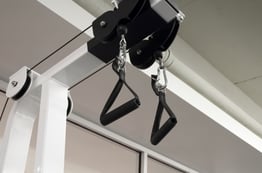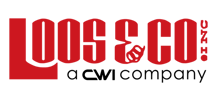 Here at Loos and Company, we get questions almost every day asking what size cable to use over a specified pulley, or what size pulley to use with a specific cable diameter or construction. These questions are important because by using a properly designed pulley system, you will be able to get a longer service life out of your cable. In general, the service life of cable and wire rope can be increased if (1) it operates over the largest possible pulley or sheave diameter, (2) it is properly supported in the pulley or sheave groove, and (3) you are using cable that’s been designed for cycling in a pulley system. The working life of the individual wire strands is greatly reduced as the pulley or sheave diameter is diminished.
Here at Loos and Company, we get questions almost every day asking what size cable to use over a specified pulley, or what size pulley to use with a specific cable diameter or construction. These questions are important because by using a properly designed pulley system, you will be able to get a longer service life out of your cable. In general, the service life of cable and wire rope can be increased if (1) it operates over the largest possible pulley or sheave diameter, (2) it is properly supported in the pulley or sheave groove, and (3) you are using cable that’s been designed for cycling in a pulley system. The working life of the individual wire strands is greatly reduced as the pulley or sheave diameter is diminished.
That said, it’s important to keep in mind that the information we provide is just a recommendation and not an absolute guideline—there are many factors to be taken into consideration, some of which we will review in this blog.
- D:d ratio considerations: D:d or, as it is affectionately referred to in the industry, the “big d to little d ratio”, speaks to the need to work with the largest pulley diameter (D) possible in relation to your cable diameter (d). All other things being equal, the larger the D:d, the longer the cable will remain in service in your specific application. There are some specific recommendations available on our website for the D:d to use in your design depending upon what cable diameter and construction you are using. This guide is a great place to start when considering the performance of your system.
- Pulley Groove: An improper pulley groove will put extra stress on a wire rope and lead to premature wear. When designing a pulley groove, the groove should always be 150% of the maximum tolerance of the wire rope. For example, let’s say you have a 1/8” 7x19 aircraft cable with a maximum tolerance of .014
 ” (.125” minimum, .139” maximum diameter). Multiplying the .014” max tolerance by 150% would equal .021”. By adding .021” to the .139” max diameter you would get .160”. This will be your pulley groove dimension.
” (.125” minimum, .139” maximum diameter). Multiplying the .014” max tolerance by 150% would equal .021”. By adding .021” to the .139” max diameter you would get .160”. This will be your pulley groove dimension.
- Cable performance design: This comes down to two words: jacket and lubrication. When a cable goes over a pulley, you want to make sure it is as smooth as possible and that the jacket will not crack. Loos and Company uses the highest quality jacketing material (an aerospace grade nylon material) to ensure the cable is smooth and lasts as long as possible. It is also important to lubricate all of the wires which make up the cable, as is the standard process here at Loos and Company. When a cable is properly lubed, it will endure more cycles and reduce friction as well as corrosion. These two items are such an important part of the performance of your pulley system that Loos and Company tests every lot of cable that we make for these applications to ensure that we maintain the highest standards in the industry.
Pulley systems are used in a wide variety of industries, from aircraft controls and stage rigging to material handling and fitness equipment. The one thing these industries have in common is that they utilize these pulleys in a capacity where human safety is a concern; so designing a system that can provide a long service life and not accelerate cable failure is a must. With nearly 60 years of experience in the cable industry, Loos and Company can work with you to recommend the proper material to create the pulley system you need in your application.
If you have any questions about pulley design or anything else, please submit an inquiry below or contact us today. We have a full team of experts on hand to answer any questions you have. And, if you are going to the IHRSA show in Orlando this year, stop by booth 2061 to learn about our exercise cable,EXERFLEXPRO®.




